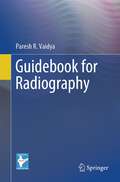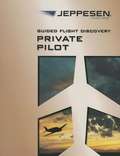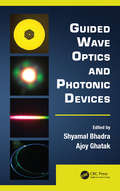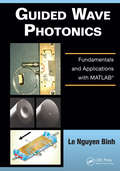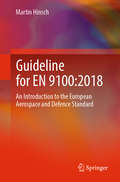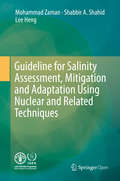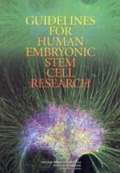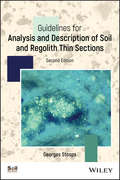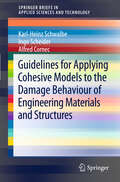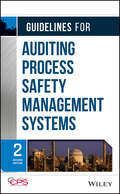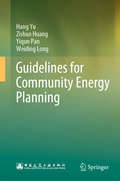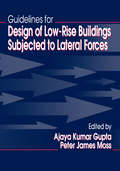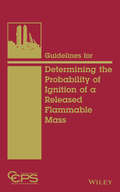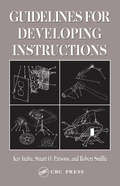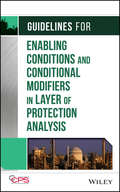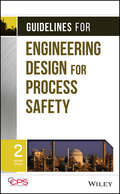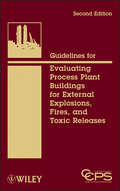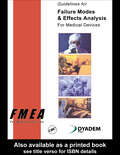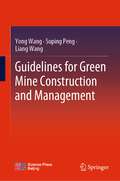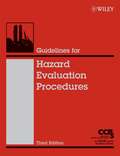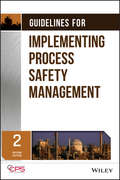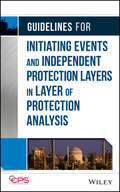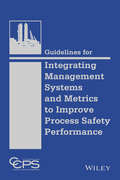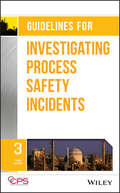- Table View
- List View
Guidebook for Radiography
by Paresh R. VaidyaThis book is a complete and compact manual on the radiographic testing. It covers every aspect of the test method including radiation safety and its modern techniques. It is specifically designed as a quick guide and reference manual for field engineers. There are chapters on basic physics of radiation, radiographic equipment, radiographic film and screen, radiography application and techniques, among others. The contents also include pedagogical features such as end-of-chapter numerical problems and chapters on ‘How to write Procedure for Testing’ and ‘How to write Instructions for Testing’ which are practical tips that are not found in standard textbooks. This book is a useful resource for professionals and researchers in the areas of radiography and radiometry.
Guided Flight Discovery: Private Pilot
by Jeppesen SandersonDivided into five parts, this textbook contains complete and concise explanations of the fundamental concepts every private pilot needs to know, with the subjects arranged in a logical manner that builds upon previously introduced topics. Throughout the manual, concepts that directly relate to FAA test questions are described in FAA Question Insets. Key terms are highlighted throughout the text and listed at the end of each section along with a checklist that summarizes important concepts.
Guided Wave Optics and Photonic Devices (Optics and Photonics)
by Ajoy Ghatak Shyamal BhadraGuided Wave Optics and Photonic Devices introduces readers to a broad cross-section of topics in this area, from the basics of guided wave optics and nonlinear optics to biophotonics. The book is inspired by and expands on lectures delivered by distinguished speakers at a three-week school on guided wave optics and devices organized at the CSIR-Central Glass and Ceramic Research Institute in Kolkata in 2011. An Introduction to Guided Wave Optics and Photonic Devices: Principles, Applications, and Future Directions The book discusses the concept of modes in a guided medium from first principles, emphasizing the importance of dispersion properties in optical fibers. It describes fabrication and characterization techniques of rare-earth-doped optical fibers for amplifiers and lasers, with an eye to future applications. Avoiding complex mathematical formalism, it also presents the basic theory and operational principles of fiber amplifiers and lasers. The book examines techniques for writing fiber Bragg gratings, which are of particular interest for smart sensing applications. A chapter focuses on the fundamental principles of Fourier optics and its implementation in guided wave optics. In addition, the book explains the critical phenomena of soliton dynamics and supercontinuum generation in photonic crystal fiber, including its fabrication process and characteristics. It also looks at plasmonics in guided media and nonlinearity in stratified media—both key areas for future research. The last chapter explores the importance of lasers in biophotonic applications. Written by experts engaged in teaching, research, and development in optics and photonics, this reference brings together fundamentals and recent advances in one volume. It offers a valuable overview of the field for students and researchers alike and identifies directions for future research in guided wave and photonic device technology.
Guided Wave Photonics: Fundamentals and Applications with MATLAB
by Le Nguyen BinhA comprehensive presentation of the theory and simulation of optical waveguides and wave propagations in a guided environment, Guided Wave Photonics: Fundamentals and Applications with MATLAB supplies fundamental and advanced understanding of integrated optical devices that are currently employed in modern optical fiber communications systems and p
Guideline for EN 9100: An Introduction to the European Aerospace and Defence Standard
by Martin HinschThe European Standard EN 9100 is the industry-specific norm of the aerospace and defence industry. For cooperation with an aerospace company, certification according to this standard is usually mandatory for suppliers.This book provides support in understanding and implementing the standard or when switching from ISO 9001:2015 to EN 9100:2018. After an introduction to the ISO 9001, the emphasis is placed on the core characteristics of EN 9100 and EN 9120. The book focuses primarily on the explanation and translation of the standards' text into the language of everyday business. The structure of the book strictly follows that of EN 9100:2018. Numerous practical examples facilitate the understanding and implementation in your own company. Where appropriate, special characteristics of the distributor standard EN 9120 are also discussed.Finally, the author describes the certification process in great detail. This includes the preparation, the selection of a certification auditor and a certification body as well as the execution of the audit including process measurements, the handling of nonconformities and the issuing of the certificate. Due to the high degree of congruence between the standards of the EN 9100 series, this book is also suitable as a guideline for the EN 9110 for maintenance organisations and the EN 9120 for distributors.The target groupThis textbook is aimed at employees working in the quality department of suppliers in the aerospace industry.
Guideline for Salinity Assessment, Mitigation and Adaptation Using Nuclear and Related Techniques
by Shabbir A. Shahid Lee Heng Mohammad ZamanThis open access book is an outcome of the collaboration between the Soil and Water Management & Crop Nutrition Section, Joint FAO/IAEA Division of Nuclear Techniques in Food and Agriculture, Department of Nuclear Sciences and Applications, International Atomic Energy Agency (IAEA), Vienna, Austria, and Dr. Shabbir A Shahid, Senior Salinity Management Expert, Freelancer based in United Arab Emirates.The objective of this book is to develop protocols for salinity and sodicity assessment and develop mitigation and adaptation measures to use saline and sodic soils sustainably. The focus is on important issues related to salinity and sodicity and to describe these in an easy and user friendly way. The information has been compiled from the latest published literature and from the authors’ publications specific to the subject matter. The book consists of six chapters. Chapter 1 introduces the terms salinity and sodicity and describes various salinity classification systems commonly used around the world. Chapter 2 reviews global distribution of salinization and socioeconomic aspects related to salinity and crop production. Chapters 3 covers comprehensively salinity and sodicity adaptation and mitigation options including physical, chemical, hydrological and biological methods. Chapter 4 discusses the efforts that have been made to demonstrate the development of soil salinity zones under different irrigation systems. Chapter 5 discusses the quality of irrigation water, boron toxicity and relative tolerance to boron, the effects of chlorides on crops. Chapter 6 introduces the role of nuclear techniques in saline agriculture.
Guidelines For Human Embryonic Stem Cell Research
by National Research Council Institute of Medicine of the National AcademiesThe National Academies Press (NAP)--publisher for the National Academies--publishes more than 200 books a year offering the most authoritative views, definitive information, and groundbreaking recommendations on a wide range of topics in science, engineering, and health. Our books are unique in that they are authored by the nation's leading experts in every scientific field.
Guidelines for Analysis and Description of Soil and Regolith Thin Sections (ASA, CSSA, and SSSA Books #184)
by Georges StoopsA revised guide to the study and of soil and regolith thin sections A specialized system of terms and concepts must be used to accurately and effectively distinguish and name the microscopic features of soils and regoliths. With a comprehensive, consistent terminology at their disposal, researchers may compare, store and discuss new data easily and with less risk of error. The second edition of Guidelines for Analysis and Description of Soil and Regolith Thin Sections has been assembled to address this need, offering a practical system of analysis and description to those working with soil and regolith materials. This essential resource includes: An introduction to micromorphology and its practice Guidelines for the study of thin sections Sections covering the various microscopic features of soils and regoliths Illustrative graphics and colour micrographs Suggested description schemes and data presentation tips By providing an economical, navigable system for the study and documentation of soils and regoliths, Guidelines for Analysis and Description of Soil and Regolith Thin Sections, second edition, offers invaluable guidance for soil scientists, geologists, ecologists, archaeologists and all those concerned with micromorphology.
Guidelines for Applying Cohesive Models to the Damage Behaviour of Engineering Materials and Structures
by Karl-Heinz Schwalbe Ingo Scheider Alfred CornecThis brief provides guidance for the application of cohesive models to determine damage and fracture in materials and structural components. This can be done for configurations with or without a pre-existing crack. Although the brief addresses structural behaviour, the methods described herein may also be applied to any deformation induced material damage and failure, e.g. those occurring during manufacturing processes. The methods described are applicable to the behaviour of ductile metallic materials and structural components made thereof. Hints are also given for applying the cohesive model to other materials.
Guidelines for Auditing Process Safety Management Systems, 2nd Edition
by CcpsThis book discusses the fundamental skills, techniques, and tools of auditing, and the characteristics of a good process safety management system. A variety of approaches are given so the reader can select the best methodology for a given audit. This book updates the original CCPS Auditing Guideline project since the implementation of OSHA PSM regulation, and is accompanied by an online download featuring checklists for both the audit program and the audit itself. This package offers a vital resource for process safety and process development personnel, as well as related professionals like insurers.
Guidelines for Community Energy Planning
by Hang Yu Zishuo Huang Yiqun Pan Weiding LongThis book systematically introduces readers to the operator method, which can be used in different stages of urban planning. Energy planning should ideally be accompanied by urban planning, ranging from comprehensive planning and detailed planning, to the design of individual construction projects. This book discusses a range of methods and models for defining energy planning objectives; analyzing and predicting energy demand; assessing available energy resources; optimizing integrated energy systems; analyzing the cost-effectiveness of proposals; implementation management; and post-assessment. Part one focuses on energy planning in different urban planning stages, while part two provides detailed discussions of key issues related to energy planning.
Guidelines for Design of Low-Rise Buildings Subjected to Lateral Forces
by Ajaya Kumar Gupta Peter James MossGuidelines for Design of Low-Rise Buildings Subjected to Lateral Forces is a concise guide that identifies performance issues, concerns, and research needs associated with low-rise buildings. The book begins with an introduction that discusses special problems with low-rise buildings subjected to wind and earthquakes. Chapter 2 examines probabilistic methods and their use in evaluating risks from natural hazards. It also addresses the characteristics of wind and seismic forces and levels of risk implied by building codes. Wind forces are covered in more detail in Chapter 3, with discussions of wind force concepts and wind-structure interactions. Chapter 4 is devoted to earthquake forces and traces the development of building codes for earthquake resistant design. Chapter 5 describes the main framing systems used to resist lateral forces and discusses the code requirements for drift control. The designs and requirements for connections between building elements are addressed in Chapter 6. It includes examples along with several illustrations of suitable connections. The performance of non-structural elements during wind and earthquake forces is also examined in detail. This book serves as an important reference for civil engineers, construction engineers, architects, and anyone concerned with structural codes and standards. It is an excellent guide that can be used to supplement design recommendations and provide a design basis where there are no current requirements.
Guidelines for Determining the Probability of Ignition of a Released Flammable Mass
by CcpsComplemented by an estimating tool spreadsheet based on a fixed set of chemicals to assist in risk estimations, Probability of Ignition of a Released Flammable Mass converts a "best guess" to a calculated value based on available information and current technology. The text documents and explains the science and background of the technology-based approach. The tool, when populated with appropriate data, yields an estimate of the probability that a defined release of a flammable material will ignite if exposed to an ignition source. This information can be used to make risk assessments with a higher degree of confidence than estimates made before and it provides valuable information for use in the development of a facility's Emergency Response Plan.
Guidelines for Developing Instructions
by Kay Inaba Stuart O. Parsons Robert J. SmillieConfusing, inadequate instructions for setting up and using consumer products are not only unhelpful, but potentially dangerous. They may contain wrong information, poor warnings, and no pictures or illustrations. Standards are either non-existent or little known, even though the U.S. government has developed and tested standards for the past thirt
Guidelines for Enabling Conditions and Conditional Modifiers in Layer of Protection Analysis
by CcpsThe initial Layer of protection analysis (LOPA) book published in 2001 set the rules and approaches for using LOPA as an intermediate method between purely qualitative hazards evaluation/analysis and more quantitative analysis methods. Basic LOPA provides an order-of-magnitude risk estimate of risk with fairly reproducible results. LOPA results are considered critical in determining safety integrity level for design of safety instrumented systems.This guideline clarifies key concepts and reinforces the limitations and the requirements of LOPA. The main scope of the guideline is to provide examples of CMs and ECs and to provide concrete guidance on the protocols that must be followed to use these concepts. The book presents a brief overview of Layer of Protection Analysis (LOPA) and its variations, and summarizes terminology used for evaluating scenarios in the context of a typical incident sequence. It defines and illustrates the most common types of ECs and CMs and shows how they interrelate to risk criteria as well as their application to other methods.
Guidelines for Engineering Design for Process Safety
by Center For Chemical Process SafetyThis updated version of one of the most popular and widely used CCPS books provides plant design engineers, facility operators, and safety professionals with key information on selected topics of interest. The book focuses on process safety issues in the design of chemical, petrochemical, and hydrocarbon processing facilities. It discusses how to select designs that can prevent or mitigate the release of flammable or toxic materials, which could lead to a fire, explosion, or environmental damage.Key areas to be enhanced in the new edition include inherently safer design, specifically concepts for design of inherently safer unit operations and Safety Instrumented Systems and Layer of Protection Analysis. This book also provides an extensive bibliography to related publications and topic-specific information, as well as key information on failure modes and potential design solutions.
Guidelines for Evaluating Process Plant Buildings for External Explosions, Fires, and Toxic Releases, 2nd Edition
by CcpsSiting of permanent and temporary buildings in process areas requires careful consideration of potential effects of explosions and fires arising from accidental release of flammable materials. This book, which updates the 1996 edition, provides a single-source reference that explains the American Petroleum Institute (API) permanent (752) and temporary (753) building recommended practices and details how to implement them. New coverage on toxicity and updated standards are also highlighted. Practical and easy-to-use, this reliable guide is a must-have for implementing safe building practices.
Guidelines for Failure Modes and Effects Analysis for Medical Devices
by Dyadem PressChallenged by stringent regulations, vigorous competition, and liability lawsuits, medical device manufactures must develop safe, reliable, and cost-effective products, and managing and reducing risk is a vital element of reaching that goal. A practical guide to achieving corporate consistency while dramatically cutting the time required for studies, Guidelines for Failure Modes and Effects Analysis for Medical Devices focuses on Failure Modes and Effects Analysis (FMEA) and its application throughout the life cycle of a medical device. It outlines the major U.S. and E.U. standards and regulations and provides a detailed yet easy-to-read overview of risk management and risk analysis methodologies, common FMEA pitfalls, and FMECA-Failure Mode, Effects, and Criticality Analysis.Discover how the FMEA methodology can help your company achieve a more cost-effective manufacturing process by improving the quality and reliability of your products. This new FMEA manual from the experts at Dyadem is the ultimate resource for you and your colleagues to learn more about Failure Modes and Effects Analysis and then teach others at your facility. This comprehensive manual is sure to become a standard reference for engineering professionals.
Guidelines for Green Mine Construction and Management
by Liang Wang Yong Wang Suping PengThis book comprehensively covers many aspects of green mine, including the basic situation of green mines, mine facilities, extraction management, ecological environment, scientific and technological innovation, standardized management, environmental protection inspectors, and special tools in response to the needs of green mine construction, assessment, and management. It is highly informative with valuable techniques and tools providing insights both for scholars and practitioners working in green mine field.
Guidelines for Hazard Evaluation Procedures
by Center For Chemical Process SafetyGuidelines for Hazard Evaluation Procedures, 3rd Edition keeps process engineers updated on the effective methodologies that process safety demands. Almost 200 pages of worked examples are included to facilitate understanding. References for further reading, along with charts and diagrams that reflect the latest views and information, make this a completely accessible work. The revised and updated edition includes information not included in previous editions giving a comprehensive overview of this topic area.
Guidelines for Implementing Process Safety Management
by CcpsThe 2nd edition provides an update of information since the publication of the first edition including best practices for managing process safety developed by industry as well as incorporate the additional process safety elements. In addition the book includes a focus on maintaining and improving a Process Safety Management (PSM) System. This 2nd edition also provides "how to information to" determine process safety performance status, implement one or more new elements into an existing PSM system, maintain or improve an existing PSM system, and manage future process safety performance.
Guidelines for Inherently Safer Chemical Processes: A Life Cycle Approach
by CcpsSince the publication of the second edition several United States jurisdictions have mandated consideration of inherently safer design for certain facilities. Notable examples are the inherently safer technology (IST) review requirement in the New Jersey Toxic Chemical Prevention Act (TCPA), and the Inherently Safer Systems Analysis (ISSA) required by the Contra Costa County (California) Industrial Safety Ordinance. More recently, similar requirements have been proposed at the U.S. Federal level in the pending EPA Risk Management Plan (RMP) revisions. Since the concept of inherently safer design applies globally, with its origins in the United Kingdom, the book will apply globally. The new edition builds on the same philosophy as the first two editions, but further clarifies the concept with recent research, practitioner observations, added examples and industry methods, and discussions of security and regulatory issues. Inherently Safer Chemical Processes presents a holistic approach to making the development, manufacture, and use of chemicals safer. The main goal of this book is to help guide the future state of chemical process evolution by illustrating and emphasizing the merits of integrating inherently safer design process-related research, development, and design into a comprehensive process that balances safety, capital, and environmental concerns throughout the life cycle of the process. It discusses strategies of how to: substitute more benign chemicals at the development stage, minimize risk in the transportation of chemicals, use safer processing methods at the manufacturing stage, and decommission a manufacturing plant so that what is left behind does not endanger the public or environment.
Guidelines for Initiating Events and Independent Protection Layers in Layer of Protection Analysis
by CcpsThe book is a guide for Layers of Protection Analysis (LOPA) practitioners. It explains the onion skin model and in particular, how it relates to the use of LOPA and the need for non-safety instrumented independent protection layers. It provides specific guidance on Independent Protection Layers (IPLs) that are not Safety Instrumented Systems (SIS). Using the LOPA methodology, companies typically take credit for risk reductions accomplished through non-SIS alternatives; i.e. administrative procedures, equipment design, etc. It addresses issues such as how to ensure the effectiveness and maintain reliability for administrative controls or "inherently safer, passive" concepts. This book will address how the fields of Human Reliability Analysis, Fault Tree Analysis, Inherent Safety, Audits and Assessments, Maintenance, and Emergency Response relate to LOPA and SIS. The book will separate IPL's into categories such as the following: Inherent Safety eliminates a scenario or fundamentally reduces a hazard Preventive/Proactive prevents initiating event from occurring such as enhanced maintenance Preventive/Active stops chain of events after initiating event occurs but before an incident has occurred such as high level in a tank shutting off the pump. Mitigation (active or passive) minimizes impact once an incident has occurred such as closing block valves once LEL is detected in the dike (active) or the dike preventing contamination of groundwater (passive).
Guidelines for Integrating Management Systems and Metrics to Improve Process Safety Performance
by CcpsThis book combines the synergies between performance improvement systems to help ensure safe and reliable operations, streamline procedures and cross-system auditing, and supporting regulatory and corporate compliance requirements. Many metrics are common to more than one area, such that a well-designed and implemented integrated management system will reduce the load on the Process Safety, SHE, Security and Quality groups, and improve manufacturing efficiency and customer satisfaction. Systems to improve performance include: process safety; traditional safety, health and environment; and, product quality. Chapters include: Integrating Framework; Securing Support & Preparing for Implementation; Establishing Common Risk Management Systems - How to Integrate PSM into Other EH; Testing Implementation Approach; Developing and Agreeing on Metrics; Management Review; Tracking Integration Progress and Measuring Performance; Continuous Improvement; Communication of Results to Different Stakeholders; Case Studies; and Examples for Industry
Guidelines for Investigating Process Safety Incidents
by CcpsThis book provides a comprehensive treatment of investing chemical processing incidents. It presents on-the-job information, techniques, and examples that support successful investigations. Issues related to identification and classification of incidents (including near misses), notifications and initial response, assignment of an investigation team, preservation and control of an incident scene, collecting and documenting evidence, interviewing witnesses, determining what happened, identifying root causes, developing recommendations, effectively implementing recommendation, communicating investigation findings, and improving the investigation process are addressed in the third edition. While the focus of the book is investigating process safety incidents the methodologies, tools, and techniques described can also be applied when investigating other types of events such as reliability, quality, occupational health, and safety incidents.
